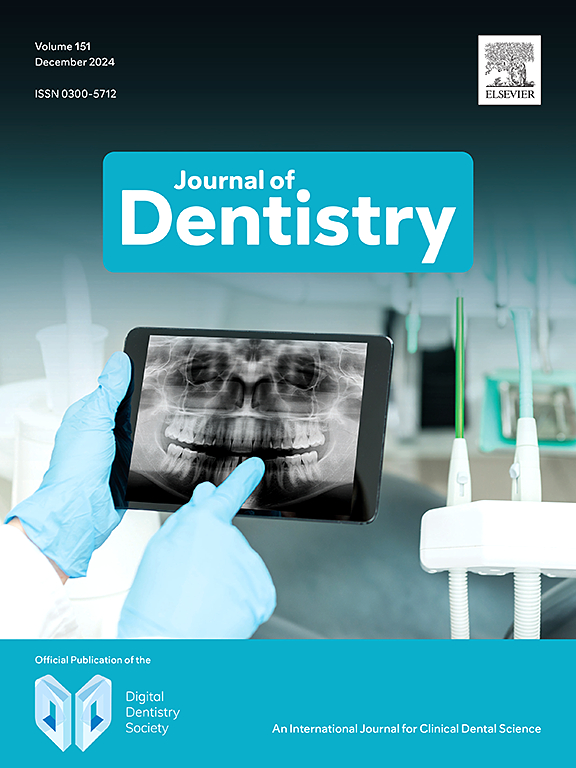基于ormocer的单色树脂复合材料修复宫颈非龋齿病变的临床性能:18个月随机临床试验
IF 4.8
2区 医学
Q1 DENTISTRY, ORAL SURGERY & MEDICINE
引用次数: 0
摘要
目的:这项双盲、裂口、随机等效临床试验旨在评估基于ormocer的单色树脂复合材料与基于ormocer的多色树脂复合材料在非龋齿宫颈病变(ncls)中的18个月临床表现。方法:采用两种修复材料(n = 60):Admira Fusion X-tra树脂复合材料(ormoser基单色)和Admira Fusion树脂复合材料(ormoser基多色)对120例ncls进行修复。橡胶坝隔离后,采用通用胶粘剂进行选择性牙釉质蚀刻。对于两组,修复体都是增量插入和光固化的。根据最新的FDI(世界牙科联合会)标准,在6、12和18个月时对修复体进行临床评估。统计学分析采用Friedman重复测量方差分析,采用秩和Mann-Whitney检验两两显著性(α = 0.05)。结果:所有修复体在18个月后进行评估,9个修复体丢失。单侧ormoer的材料断裂率和保留率(95%置信区间[CI])为93% (84-97 CI),多侧ormoer的材料断裂率和保留率为91% (82-96 CI),两者之间无统计学差异(p < 0.05)。绝对风险(95% CI)为0.8(0.2 ~ 3.1)。结论:更新后的FDI评价标准在18个月后显示基于ormocer的单色和基于ormocer的多色结果相当。临床意义:与ormocer基多色复合材料相比,使用ormocer基单色树脂复合材料在不影响临床性能的情况下,方便,易于应用,成本更低,因此在ncls中使用ormocer基单色树脂复合材料是可取的。本文章由计算机程序翻译,如有差异,请以英文原文为准。
Clinical performance of an ormocer-based single-shade resin composite for the restoration of non-carious cervical lesions: 18-month randomized clinical trial
Objective
This double-blind, split-mouth, randomized equivalence clinical trial aimed to evaluate the 18-month clinical performance of an ormocer-based single-shade resin composite compared with an ormocer-based multi-shade resin composite in non-carious cervical lesions (NCCLs).
Methods
One hundred and twenty restorations were performed on NCCLs with two restorative materials (n = 60): Admira Fusion X-tra resin composite (ormocer-based single-shade), and Admira Fusion resin composite (ormocer-based multi-shade). After rubber dam isolation, a universal adhesive was applied in the selective enamel etching strategy. For both groups, restorations were inserted incrementally and light-cured. The restorations were clinically evaluated at 6, 12, and 18 months according to the updated FDI (World Dental Federation) criteria. Statistical analysis was performed using Friedman repeated measures ANOVA by rank and Mann-Whitney test for pairwise significance (α = 0.05).
Results
All restorations were evaluated after 18 months, and nine restorations were lost. Fracture of the material and retention rates (95 % confidence interval [CI]) were 93 % (84–97 CI) for the ormocer-based single-shade and 91 % (82–96 CI) for the ormocer-based multi-shade, with no statistical differences between them (p > 0.05). The absolute risk (95 % CI) was 0.8 (0.2 to 3.1).
Conclusions
The updated FDI evaluation criteria showed equivalent results for ormocer-based single-shade and ormocer-based multi-shade after 18 months.
Clinical significance
Using an ormocer-based single-shade resin composite in NCCLs is advisable due to its convenience, ease of application, and lower cost compared to ormocer-based multi-shade composites without compromising clinical performance.
求助全文
通过发布文献求助,成功后即可免费获取论文全文。
去求助
来源期刊

Journal of dentistry
医学-牙科与口腔外科
CiteScore
7.30
自引率
11.40%
发文量
349
审稿时长
35 days
期刊介绍:
The Journal of Dentistry has an open access mirror journal The Journal of Dentistry: X, sharing the same aims and scope, editorial team, submission system and rigorous peer review.
The Journal of Dentistry is the leading international dental journal within the field of Restorative Dentistry. Placing an emphasis on publishing novel and high-quality research papers, the Journal aims to influence the practice of dentistry at clinician, research, industry and policy-maker level on an international basis.
Topics covered include the management of dental disease, periodontology, endodontology, operative dentistry, fixed and removable prosthodontics, dental biomaterials science, long-term clinical trials including epidemiology and oral health, technology transfer of new scientific instrumentation or procedures, as well as clinically relevant oral biology and translational research.
The Journal of Dentistry will publish original scientific research papers including short communications. It is also interested in publishing review articles and leaders in themed areas which will be linked to new scientific research. Conference proceedings are also welcome and expressions of interest should be communicated to the Editor.
 求助内容:
求助内容: 应助结果提醒方式:
应助结果提醒方式:


